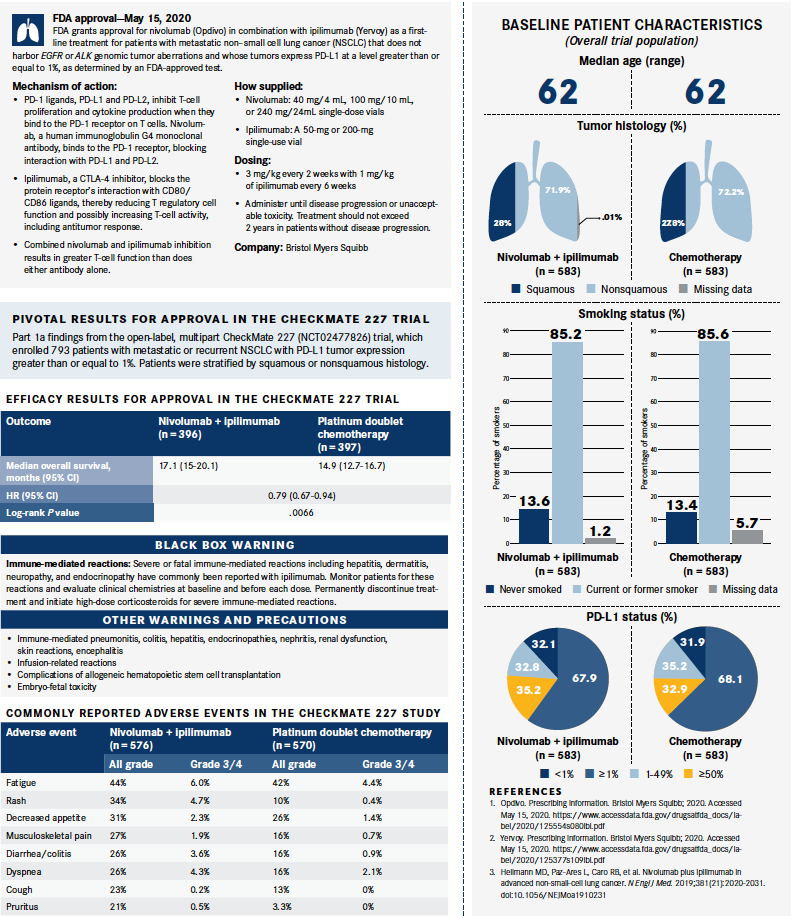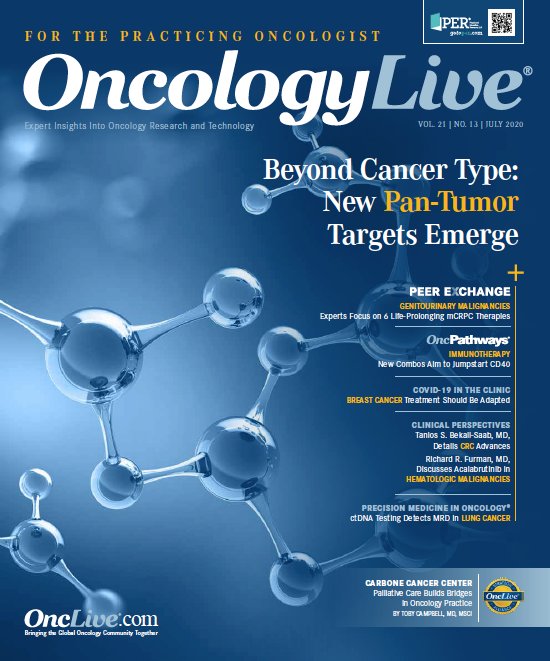Regimen Doubles Down on Immunotherapy to Improve NSCLC Outcomes
Suresh S. Ramalingam, MD, discusses the combination of nivolumab and ipilimumab in metastatic non–small cell lung cancer.
Suresh S. Ramalingam, MD

The combination of nivolumab (Opdivo), a PD-1 inhibitor, plus ipilimumab (Yervoy), a CTLA-4 inhibitor, provides more durable responses and longer survival than standard platinum doublet chemotherapy for a subgroup of patients with metastatic non–small cell lung cancer (NSCLC).
On May 15, 2020, the FDA approved the combination as a first-line therapy for patients with metastatic NSCLC whose tumors do not have EGFR or ALK aberrations and express PD-L1 at a level of at least 1%, as determined by an FDA-approved test.
The immunotherapy doublet’s indication is based on findings from part 1a of the phase 3 CheckMate 227 trial (NCT02477826), which compared the combination with platinum-based chemotherapy in 793 patients with metastatic or recurrent disease whose tumors expressed PD-L1 at a level greater than or equal to 1%.1 The overall population comprised 1166 patients stratified by PD-L1 expression levels.
On May 26, 2020, the dual immunotherapy regimen also was approved in combination with 2 cycles of platinum doublet chemotherapy as first-line treatment for patients with metastatic or recurrent NSCLC who do not have EGFR or ALK alterations.
In an interview with OncLive, Suresh S. Ramalingam, MD, deputy director of the Winship Cancer Institute of Emory University and assistant dean of cancer research at Emory University School of Medicine in Atlanta, Georgia, discussed the regimen.
OncLive: What is significant about the CheckMate 227 data?
Ramalingam: This is the first time that a non–chemotherapy-containing combination immunotherapy approach has resulted in a survival advantage in non–small cell lung cancer for the patient population with greater than 1% PD-L1 expression. There were 1166 patients in this nivolumab plus ipilimumab versus chemotherapy comparison; we saw a statistically significant improvement in overall survival. The median overall survival was 17.1 months with nivolumab and ipilimumab [versus] 14.9 months with chemotherapy, with a hazard ratio of 0.79.
One of the most notable things about the immunotherapy combination is the duration of response in the patients who responded. The median duration of response was approximately 23 months, whereas with chemotherapy, it was only 6 months. The fact that durable responses can be achieved with the immunotherapy combination is an important reason to consider this regimen in the frontline treatment of non–small cell lung cancer.

Please describe the doublet therapy’s safety profile.
The combination was generally well tolerated. Grade 3 or 4 adverse events were seen in approximately 33% of the patients [who received] nivolumab and ipilimumab. When you look at the autoimmune adverse events, which is the most pertinent [category] of events that we think about when making treatment decisions, the most common toxicities with the combination were grade 1 or 2 in severity. Diarrhea, skin rash, and fatigue were all seen in 15% to 17% of the patients and were mostly grade 1 or 2. Grade 3 and 4 toxicities were seen in a relatively small percentage of patients exposed.
What is the rationale for combining these agents?
This combination has been studied in melanoma and is an approved strategy. The underlying premise is that when you block PD-1, there is upregulation of other checkpoints; notably, CTLA-4. [Therefore,] with combined blockade of both PD-1 and CTLA-4, there is an activated T-cell population that has been reversed from its exhausted state to exert maximum anticancer activity.
How does the approval advance the NSCLC paradigm?
For patients with advanced-stage non–small cell lung cancer, our frontline treatment paradigm is based on PD-L1 expression. For patients who have a greater than 50% PD-L1 expression, we use pembrolizumab (Keytruda) monotherapy, and for patients with expression less than 50%, we use chemotherapy plus pembrolizumab. Chemotherapy plus atezolizumab [Tecentriq] is also approved in this setting. For these patients, we use PD-L1 as the main biomarker.
Before we do that, we also test for molecular drivers in nonsquamous patients, and those with driver mutations are treated with targeted therapies. There are at least 7 targets [that correspond with] FDA-approved agents. We want oncologists to emphasize that frontline treatment should be started after you have the full molecular status of these patients.
The nivolumab plus ipilimumab regimen is likely to fit in [among] the low PD-L1 expressing patients, where, right now, [we administer] chemotherapy plus immunotherapy. Given the data from CheckMate 227, the combination would be appropriate for consideration in that setting. We also saw improvement in overall survival in the less-than-1% PD-L1 expression [group] with nivolumab and ipilimumab.
What are the next steps for this regimen?
Another trial that involves the combination of chemotherapy plus nivolumab and ipilimumab in advanced non–small cell lung cancer [CheckMate-9LA; NCT03215706] was presented at the 2020 American Society of Clinical Oncology Virtual Scientific Program. This combination recently received FDA approval for the first-line treatment of advanced NSCLC.
The combination of nivolumab and ipilimumab is also being studied in locally advanced non–small cell lung cancer. Finally, we also heard about a press release that showed that nivolumab plus ipilimumab improved overall survival for patients with malignant mesothelioma [in the phase 3 CheckMate-743 study (NCT02899299)]. These exciting developments pave the way for using nivolumab and ipilimumab beyond the frontline treatment of non–small cell lung cancer into other settings and even other diseases.
Reference:
- FDA approves nivolumab plus ipilimumab for first-line mNSCLC (PD-L1 tumor expression ≥1%). FDA. May 15, 2020. Accessed May 18, 2020. https://www.fda.gov/drugs/drug-approvals-and-databases/fda-approves-nivolumab-plus-ipilimumab-first-line-mnsclc-pd-l1-tumor-expression-1




